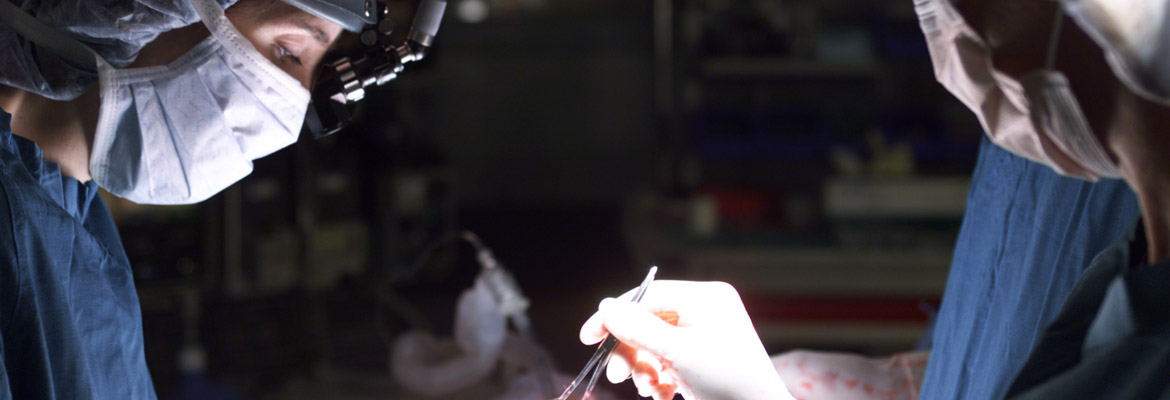


The National Science Foundation (NSF) gave CHOP molecular biologist Adam Resnick, PhD, a five-year award to study inositol pyrophosphates, a new class of signaling molecules. Dr. Resnick’s award is one of only a handful of active NSF awards given to Children’s Hospital investigators.
Found in all eukaryotic cells, inositol pyrophosphates “play roles in diverse processes,” said Dr. Resnick, an assistant professor of neurosurgery at the University of Pennsylvania School of Medicine. “They do novel things — they modify proteins in new ways.”
Dr. Resnick and Phillip B. “Jay” Storm, MD, chief of neurosurgery, study cell signaling in pediatric brain tumors, working to better understand tumors at a molecular and genetic level.
The inositol pyrophosphate project is a good fit for the NSF, Dr. Resnick said, because his lab conducts a fundamental level of research, while at the same time it is committed to translational research. After all, in order to perform translational research, scientists first have to know how cells work, he added.
The project will feature specific opportunities for undergraduate, graduate, and medical school students to receive basic research training in the context of the laboratory’s translational science endeavors. Students will have the chance to get a “real authentic view of the importance of basic, fundamental research in the context of a children’s hospital setting,” Dr. Resnick said.

Beckwith-Wiedemann Syndrome (BWS) occurs in approximately 1 out of 13,700 births and is associated with an increased risk of childhood cancers, in particular the kidney cancer Wilms’ tumor and hepatoblastoma, a form of liver cancer.
“Up to 25 percent of children with BWS develop tumors, but we do not have a good understanding of why they do,” said Jennifer Kalish, MD, PhD, an attending physician in the Division of Genetics.
In an attempt to understand why only some children with BWS develop tumors, and to work to develop better screening markers, Dr. Kalish is conducting a two-part study. She is simultaneously developing a mouse model of the disease, as well as deriving induced pluripotent stem cells from BWS patients’ fibroblasts.
The focus of the mouse model will be on the role particular genes play in BWS and tumor development. Dr. Kalish’s investigations will focus on chromosome 11, as several genes’ expression there is altered in BWS and other cancers, including neuroblastoma, a form of childhood cancer that is responsible for 10 to 15 percent of all childhood cancer-related deaths.
“This region is dysregulated in other cancers, outside of BWS cancers, so there is clearly something about this region that is leading to tumors,” Dr. Kalish said, pointing out that the new investigation, coupled with the fact that she has been receiving BWS referrals from throughout the country and the world, could give researchers the ability to take a more comprehensive look at BWS patients’ long-term health and tumor risk.
“Ultimately, we would like to have better markers to screen for, a better understanding of why these children get tumors, but most importantly possible treatments,” she said.

The epilepsy advocacy organization Citizens United for Research in Epilepsy (CURE) gave a “Taking Flight” award to a Children’s Hospital neurologist to study how transplanted cells could be used to treat epilepsy.
Ethan Goldberg, MD, PhD, was one of three researchers to receive a one-year grant of up to $100,000 designed to “promote the careers of young investigators and support them as they develop an independent research focus,” according to CURE.
A brain disorder marked by seizures of varying intensity and type, epilepsy affects approximately 2 million Americans. With this investigation, Dr. Goldberg seeks novel treatments for forms of epilepsy that are resistant to standard medication. Using a mouse model, his research team will assess the “functional integration of transplanted interneurons” as well as whether transplanted cells can reduce or eliminate seizures in patients with epilepsy.
“Cell-based therapies offer hope of a future cure for our patients who are in greatest need, although significant additional basic science research is required to realize this potential,” Dr. Goldberg said. “This generous grant from CURE will greatly assist in getting this project off the ground and pushing it forward.”
Children’s Hospital has a robust epilepsy treatment and research program. Part of its Division of Neurology, the Pediatric Regional Epilepsy Program’s multidisciplinary team of clinicians, nurse practitioners, and researchers collaborate with families to design personalized treatment plans that best control epilepsy with as few side effects as possible.

The National Institute on Aging awarded a Children’s Hospital researcher a four-year grant to investigate the role biological errors play in age-related diseases such as Alzheimer’s disease, Parkinson’s disease, Huntington’s disease, and Amyotrophic Lateral Sclerosis.
The NIA grant will support Marc Vermulst, PhD, of the Center for Mitochondrial and Epigenomic Medicine, in his investigation of the role non-genetic errors made during cell transcription and translation play in age-related diseases.
This is a new, “non-DNA centric way to understand how aging results ultimately in age-related diseases,” Dr. Vermulst said. He has developed a number of novel assays to conduct this research, which he hopes may significantly deepen the understanding of aging and age-related pathology and help identify new targets for treatments or prevention strategies in the clinic.
In their experiments, Dr. Vermulst and his team increased the error rate of transcription in living cells and found features that are indicative of accelerated aging. For example, he pointed out that some age-related diseases are caused by an aggregation of proteins. As the researchers increased the error rate of transcription, they also increased the rate at which these proteins aggregated, which suggests that a link exists between transcription errors and age-related diseases.
While his investigation is basic and clinical applications of the work remain in the future, Dr. Vermulst said the project’s focus on establishing a better understanding of the mechanisms of aging could lead to future treatment strategies.

A Department of Defense (DoD) grant to The Children’s Hospital of Philadelphia will fund a new study focused on vascularized composite allotransplantation, a type of transplantation in which multiple tissues — such as an entire hand — are transplanted as a functional unit.
With this four-year, $2 million grant, CHOP and the University of Pennsylvania join a consortium of institutions — including the University of Maryland and the Christine M. Kleinert Institute for Hand and Microsurgery — led by Emory University that will examine advanced transplantation techniques through the DoD’s Restorative Transplantation Research program. Overall, the research program seeks to make a significant impact on improving the function, wellness, and overall quality of life for wounded members of the military
Wayne Hancock, MBBS, PhD, chief of CHOP’s Division of Transplant Immunology, will be the study’s principal investigator, and his aim is to develop new approaches to immunosuppression.
L. Scott Levin, MD, FACS, the Paul B. Magnuson Professor of Bone and Joint Surgery at the University of Pennsylvania, will lead Penn’s efforts. Matthew H. Levine, MD, PhD, assistant professor of surgery at the University of Pennsylvania, will contribute to the investigation.

Children who have experienced adversity are the true experts in understanding which childhood exposures were stressful and traumatic for them. A Children’s Hospital of Philadelphia researcher has been striving to incorporate these children’s voices into public health measures.
With the support of the Philadelphia-based Stoneleigh Foundation, the work of Roy Wade, Jr., MD, PhD, MPH, an attending physician and public health researcher, will build on the results of a major study published in Pediatrics, which sought to add the perspectives of low-income inner-city youth to measures of adverse childhood experiences (ACEs).
A previous study showed that ACEs such as abuse, neglect, and household dysfunction are major risk factors for leading causes of illness and death as well as poor quality of life in the U.S.; however, that research did not consider chronic ACEs that affect disadvantaged youth such as pervasive community violence, economic hardship, and racial discrimination.
In the Pediatrics study, alongside Children’s Hospital’s Joanne Wood, MD, MSHP, and David Rubin, MD, MSCE, as well as the University of Pennsylvania’s Judy A. Shea, PhD, Dr. Wade conducted a series of focus groups with low-income inner-city young adults 18 to 26 years old to get their perspectives on ACEs. After meeting with a total of 105 participants, the researchers found that stress related to family relationships (such as domestic substance abuse and domestic violence) was the most common ACE cited. The second most commonly cited area was community stressors, including “neighborhood violence, crime, and death.”
Overall, Dr. Wade and his team concluded that assessments of childhood adversity “should include experiences relevant to the target population,” and ACE research “should be broadened to include stressors experienced by youth in low-income urban settings.”
That is precisely what Dr. Wade’s current project, funded both by the Stoneleigh Foundation as well as the Perelman School of Medicine’s Center of Excellence for Diversity in Health Education and Research, aims to do. Over the course of this three-year project, Dr. Wade will be working “to build a youth-informed measure of childhood adversity that is informed by kids but also informed by the organizations that actually use the instrument,” he said.
He is gathering input from organizations across healthcare, social service, and youth mentoring groups to create the measure, which will eventually be adopted by the partner organizations. Dr. Wade then plans to gauge the impact of the tool and adversity assessment on each organization’s work, seeking to measure how it changes practice “in unforeseen ways,” he said.
In contrast to the Pediatrics study, with this project Dr. Wade is looking to recruit children as young as 8 years old. The measure itself will be a series of questions, as part of interviews that will validate the framework of areas of concern established by the Pediatrics study.
“We’re giving these kids a voice where they didn’t have one,” he said, adding that the project will allow children who have experienced adversity “an opportunity to speak about their life experiences.”
Dr. Wade’s hope is that by creating an assessment tool and promoting its use, he and the organizations involved will create a dialogue between children, their families, and providers that facilitates open discussion of trauma.